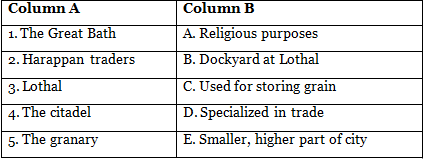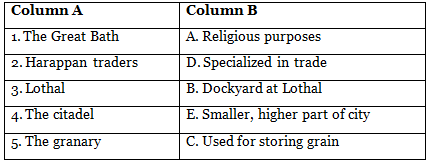Worksheet Solutions: Civilisation and Cities | Footprints Class 6: Book Solutions, Notes & Worksheets PDF Download
Q1: Multiple Choice Questions (MCQs)
(i) Who discovered the ruins of Harappa?
(a) Daya Ram Sahni
(b) Rakhaldas Banerji
(c) John Marshall
Ans: (a)
Daya Ram Sahni was the archaeologist who discovered the ruins of Harappa.
(ii) What was the largest building found in Mohenjodaro?
(a) A town hall
(b) A granary
(c) The citadel
Ans: (b)
The largest building found in Mohenjodaro was a granary used for storing surplus grain.
(iii) Which of the following statements is not true for Mohenjodaro?
(a) Bricks were used for making buildings in Mohenjodaro.
(b) The citadel was a rectangular structure resembling a swimming pool.
(c) The city had a well-constructed drainage system.
Ans: (b)
The citadel was a smaller, higher part of the city with special buildings.
(iv) The Harappan cities were divided into:
(a) The upper and the middle town.
(b) The town hall and the granary.
(c) The citadel and the lower town.
Ans: (c)
Harappan cities were divided into the upper town (citadel) and the lower town.
(v) The Harappan site in India that has a dockyard is:
(a) Ropar.
(b) Lothal.
(c) Rakhigarhi.
Ans: (b)
Lothal is the Harappan site in India known for its dockyard.
Q2: Fill in the Blanks
(i) The Harappan script has not been __________.
Ans: deciphered.
The Harappan script has not been understood or translated.
(ii) The drainage system of the Harappan cities was one of the best in __________ times.
Ans: ancient.
The Harappans had an advanced drainage system compared to other ancient civilizations.
(iii) Streets at Harappa were oriented from __________ to __________.
Ans: east; west.
The streets were laid out in an east-west direction.
(iv) The Harappans likely worshipped trees and __________.
Ans: animals.
The Harappans probably worshipped trees and animals.
(v) The Harappan Civilisation lasted for about __________ years.
Ans: a thousand.
The Harappan Civilisation existed for approximately a thousand years.
Q3: Match the Column
Match the items from Column A with the appropriate items from Column B:
 Ans:
Ans:
Q4: True or False
(i) The Harappan script has been successfully deciphered.
Ans: False
The Harappan script has not been deciphered.
(ii) Sindh and Rajasthan were deserts during the Harappan Civilisation.
Ans: False
Sindh and Rajasthan were not deserts during the Harappan Civilisation.
(iii) The drainage system in the Harappan cities was poorly planned.
Ans: False
The drainage system was one of the best in ancient times.
(iv) The Harappans likely worshipped only trees.
Ans: False
They probably worshipped both trees and animals.
(v) The Harappan Civilisation lasted for about 500 years.
Ans: False
The Harappan Civilisation lasted for about a thousand years.
|
65 videos|127 docs|25 tests
|
FAQs on Worksheet Solutions: Civilisation and Cities - Footprints Class 6: Book Solutions, Notes & Worksheets
| 1. What are some examples of early civilizations? |  |
| 2. How did cities contribute to the development of civilizations? |  |
| 3. What factors led to the decline of ancient civilizations? |  |
| 4. How did the invention of writing impact ancient civilizations? |  |
| 5. What were some common characteristics of ancient cities? |  |
















